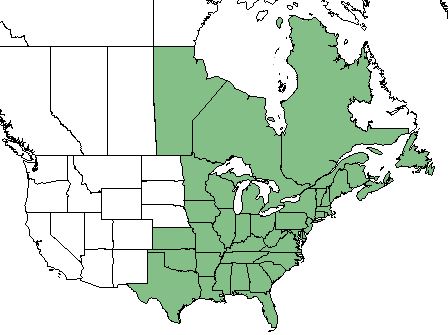Osmunda spectabilis
Common name: royal fern[1], American royal fern[2]
| Osmunda spectabilis | |
|---|---|

| |
| Photo by John Hilty at IllinoisWildflowers.info | |
| Scientific classification | |
| Kingdom: | Plantae |
| Division: | Pteridophyta – Ferns |
| Class: | Filicopsida |
| Order: | Polypodiales |
| Family: | Osmundaceae |
| Genus: | Osmunda |
| Species: | O. spectabilis |
| Binomial name | |
| Osmunda spectabilis L. | |

| |
| Natural range of Osmunda spectabilis from USDA NRCS Plants Database. | |
Contents
Taxonomic Notes
Synonyms: O. regalis Linnaeus var. spectabilis (Willdenow) A. Gray.[3]
Varieties: none.[3]
Description
O. spectabilis is a perennial forb/herb of the Osmundaceae family native to North America, Canada, and St. Pierre and Miquelon (France).[1] The leaves are bipinnate, with each pinna fully divided into distinct pinnules. The larger pinnules are 3-7 cm long and 0.7-2.0 cm wide. The leaves are also hemidimorphic, where the sterile pinnules 30-70 mm long and 8-23 mm wide, serrulate, rounded basally, and apically acute. The fertile pinnules are 7-11 mm long and 2-3 mm wide. Spores are borne on modified pinnae in the terminal portion of the leaf blade. The veins are mostly 2-forked.[3]
Distribution
O. spectabilis ranges from Newfoundland to Manitoba, then south to southern Florida and eastern Texas. It also grows from Mexico through Central America and southern South America, as well as the West Indies.[3]
Ecology
Habitat
O. spectabilis proliferates in bogs, marshes (including tidal), moist forests, floodplains, swamp forests, and other wetlands.[2] Specimens have been collected from moist loamy sand, swamp bank, clearing of floddplain on edge of creek, ditch, swampy woodland, old cypress stump, cypress depression in flatwoods, limestone ridge, cypress gum swamp, pine forest after recent burn, shaded streambank in bottomland hardwood, and edge of mesic woods.[4]
Phenology
O. spectabilis has been observed flowering March through June.[3]
Fire ecology
O. spectabilis is not fire resistant and has a low fire tolerance;[1] despite this, populations on the Wade Tract in south Georgia have been known to persist through repeated annual burning.[5]
Conservation, cultivation, and restoration
O. spectabilis is listed as commercially exploited by the Florida Department of Agriculture & Consumer Services Division of Plant Industry, as threatened by the Iowa Department of Natural Resources Parks Recreation and Preserves Division, and as exploitably vulnerable by the New York Department of Environmental Conservation Division of Land and Forests.[1]
Cultural use
Photo Gallery
References and notes
- ↑ 1.0 1.1 1.2 1.3 USDA Plant Database https://plants.usda.gov/core/profile?symbol=OSRES#
- ↑ 2.0 2.1 Weakley, A. S. (2015). Flora of the Southern and Mid-Atlantic States. Chapel Hill, NC, University of North Carolina Herbarium.
- ↑ 3.0 3.1 3.2 3.3 3.4 Weakley, A.S. 2015. Flora of the southern and mid-atlantic states. Working Draft of 21 May 2015. University of North Carolina at Chapel Hill, Chapel Hill, North Carolina.
- ↑ URL: http://herbarium.bio.fsu.edu. Last accessed: June 2018. Collectors: Loran C. Anderson, Garrett Crow, Dora Engrid Rivera, Roy Komarek, R.K. Godfrey, Robert Lemaire, Andre Clewell, J.P. Gillespie, Richard Mitchell, L.B. Trott, S. W. Leonard, John Nelson, F.C> James, Gary Knight, Elmar Prichard, K. Craddock Burks, K.M. Meyer, A. Townesmith, R.L. Wilbur, Marilyn Gillespie, Samual Jones, John Thieret, P.L. Redfearn, Donna M. Eggers, Delzie Demaree, A.J. SHarp, Robert Britt, Jean Wooten, Sidney McDaniel, H.A. Wahl, Harry Ahles, R.P. Ashworth, James D. Ray, W.J. Cody, Van L. Rens, Scott McCoy, H.B. Parks, Eunice Mitchell, Elizabeth Vandell. States and counties: Florida (Liberty, Leon, Gadsden, Brevard, Indian River, Walton, Citrus, St. Johns, Jackson, Wakulla, Calhoun, Hernando, Hillsborough, Jefferson, Flagler, Santa Rosa, Franklin, Putnam, Holmes, Gulf) Georgia (Grady, Thomas) South Carolina (Berkeley, Beaufort) Mississippi (Harrison, Newton) Alabama (Limestone, Geneva) North Carolina (Durham, Wayne, Chowan, Scotland) Texas (Van Zandt, Nacogdoches) Indiana (Jennings) Pennsylvania (Lycoming) Missouri (Ste. Genevieve) Louisiana (Allen)
- ↑ Platt, W.J., R. Carter, G. Nelson, W. Baker, S. Hermann, J. Kane, L. Anderson, M. Smith, K. Robertson. 2021. Unpublished species list of Wade Tract old-growth longleaf pine savanna, Thomasville, Georgia.